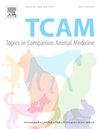Epidural administration of tramadol does not provide sufficient intraoperative analgesia for elective ovariohysterectomy in healthy cats
IF 1.3
3区 农林科学
Q2 VETERINARY SCIENCES
引用次数: 0
Abstract
Few studies today address trans-operative analgesia provided by tramadol without local anesthetics for intra-abdominal procedures. The objective of this study was to assess the efficacy of trans-operative analgesia provided by epidurally administered tramadol in cats undergoing elective ovariohysterectomy. For this purpose, 16 healthy queens were randomly assigned to participate in one of two groups: GC, control group, 0.9% NaCl at 0.3 mL/kg; and GT, tramadol group, tramadol 1 mg/kg in saline to the same final volume. Subjects received premedication with ketamine, xylazine and morphine and were anesthetized and maintained with a propofol infusion at 0.4-0.8 mg/kg/min until the end of surgery. Variables heart rate (HR), respiratory rate (FR) and systolic blood pressure (SAP) were recorded before epidural injection (TB), 5 minutes after epidural injection (TAE), at surgical incision of the skin (TSI), at clamping of the first ovarian pedicle (TP1), at clamping of the second pedicle (TP2), at clamping of the uterine stump (TU), at the beginning of abdominal cavity closure (TC) and at the final suture of the skin (TFS). A bolus of fentanyl 2 μg/kg was administered IV in case of a 20% increase of physiologic variables during these times. At the end of the study, data was analyzed using ANOVA for repeated measures followed by Tukey test. The number of fentanyl boluses was compared between groups using Kruskal-Wallis followed by Dunn test. All analyses were performed under 5% significance. There were no significant differences in HR, FR and SAP between groups. Only a mild difference was seen in HR in GT at times MP1, MP2, MU and MC compared to baseline (before epidural injections). There were no differences in number of fentanyl boluses between groups, with median (range) of 3 (1–5) in GC and 3 (1–4) in GT. In conclusion, tramadol given epidurally to cats undergoing elective ovariohysterectomy does not provide reliable intraoperative analgesia, and therefore other strategies are necessary to ensure intraoperative analgesia of healthy cats during elective ovariohysterectomy.
曲马多硬膜外给药不能为健康猫择期卵巢子宫切除术提供足够的术中镇痛。
目前很少有研究涉及曲马多在腹内手术中不使用局麻药的术中镇痛。本研究的目的是评估硬膜外给药曲马多对择期卵巢子宫切除术猫的术中镇痛效果。为此,将16只健康的蜂王随机分为两组:GC组,对照组,0.9% NaCl, 0.3 mL/kg;GT组曲马多1 mg/kg生理盐水至等量。用药前给予氯胺酮、噻嗪和吗啡,麻醉后以0.4 ~ 0.8 mg/kg/min异丙酚输注维持至手术结束。记录硬膜外注射前(TB)、硬膜外注射后5分钟(TAE)、皮肤手术切口(TSI)、卵巢第一个蒂夹紧(TP1)、第二个蒂夹紧(TP2)、子宫残端夹紧(TU)、腹腔闭合开始(TC)和皮肤最后缝合(TFS)时的可变心率(HR)、呼吸频率(FR)和收缩压(SAP)。在此期间,如果生理指标增加20%,则静脉注射芬太尼2 μg/kg。研究结束时,采用方差分析对重复测量数据进行分析,并进行Tukey检验。采用Kruskal-Wallis和Dunn试验比较各组芬太尼剂量。所有分析均在5%显著性下进行。两组间HR、FR、SAP均无显著差异。与基线(硬膜外注射前)相比,GT患者MP1、MP2、MU和MC时的HR仅有轻微差异。各组之间芬太尼丸的数量没有差异,GC组中位(范围)为3 (1-5),GT组中位(范围)为3(1-4)。综上所示,选择性卵巢子宫切除术猫硬膜外给曲马多不能提供可靠的术中镇痛,因此需要其他策略来确保健康猫在选择性卵巢子宫切除术期间的术中镇痛。
本文章由计算机程序翻译,如有差异,请以英文原文为准。
求助全文
约1分钟内获得全文
求助全文
来源期刊

Topics in companion animal medicine
农林科学-兽医学
CiteScore
2.30
自引率
0.00%
发文量
60
审稿时长
88 days
期刊介绍:
Published quarterly, Topics in Companion Animal Medicine is a peer-reviewed veterinary scientific journal dedicated to providing practitioners with the most recent advances in companion animal medicine. The journal publishes high quality original clinical research focusing on important topics in companion animal medicine.
 求助内容:
求助内容: 应助结果提醒方式:
应助结果提醒方式:


